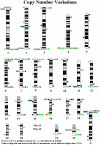Clinical implementation of chromosomal microarray analysis: summary of 2513 postnatal cases
- PMID: 17389918
- PMCID: PMC1828620
- DOI: 10.1371/journal.pone.0000327
Clinical implementation of chromosomal microarray analysis: summary of 2513 postnatal cases
Abstract
Background: Array Comparative Genomic Hybridization (a-CGH) is a powerful molecular cytogenetic tool to detect genomic imbalances and study disease mechanism and pathogenesis. We report our experience with the clinical implementation of this high resolution human genome analysis, referred to as Chromosomal Microarray Analysis (CMA).
Methods and findings: CMA was performed clinically on 2513 postnatal samples from patients referred with a variety of clinical phenotypes. The initial 775 samples were studied using CMA array version 4 and the remaining 1738 samples were analyzed with CMA version 5 containing expanded genomic coverage. Overall, CMA identified clinically relevant genomic imbalances in 8.5% of patients: 7.6% using V4 and 8.9% using V5. Among 117 cases referred for additional investigation of a known cytogenetically detectable rearrangement, CMA identified the majority (92.5%) of the genomic imbalances. Importantly, abnormal CMA findings were observed in 5.2% of patients (98/1872) with normal karyotypes/FISH results, and V5, with expanded genomic coverage, enabled a higher detection rate in this category than V4. For cases without cytogenetic results available, 8.0% (42/524) abnormal CMA results were detected; again, V5 demonstrated an increased ability to detect abnormality. Improved diagnostic potential of CMA is illustrated by 90 cases identified with 51 cryptic microdeletions and 39 predicted apparent reciprocal microduplications in 13 specific chromosomal regions associated with 11 known genomic disorders. In addition, CMA identified copy number variations (CNVs) of uncertain significance in 262 probands; however, parental studies usually facilitated clinical interpretation. Of these, 217 were interpreted as familial variants and 11 were determined to be de novo; the remaining 34 await parental studies to resolve the clinical significance.
Conclusions: This large set of clinical results demonstrates the significantly improved sensitivity of CMA for the detection of clinically relevant genomic imbalances and highlights the need for comprehensive genetic counseling to facilitate accurate clinical correlation and interpretation.
Conflict of interest statement
Figures


Similar articles
-
Prenatal diagnosis by chromosomal microarray analysis.Fertil Steril. 2018 Feb;109(2):201-212. doi: 10.1016/j.fertnstert.2018.01.005. Fertil Steril. 2018. PMID: 29447663 Free PMC article. Review.
-
Microarray-based comparative genomic hybridization analysis in neonates with congenital anomalies: detection of chromosomal imbalances.J Pediatr (Rio J). 2015 Jan-Feb;91(1):59-67. doi: 10.1016/j.jped.2014.05.007. Epub 2014 Sep 6. J Pediatr (Rio J). 2015. PMID: 25203518
-
Cryptic and complex chromosomal aberrations in early-onset neuropsychiatric disorders.Am J Hum Genet. 2014 Oct 2;95(4):454-61. doi: 10.1016/j.ajhg.2014.09.005. Am J Hum Genet. 2014. PMID: 25279985 Free PMC article.
-
Experience of chromosomal microarray applied in prenatal and postnatal settings in Hong Kong.Am J Med Genet C Semin Med Genet. 2019 Jun;181(2):196-207. doi: 10.1002/ajmg.c.31697. Epub 2019 Mar 23. Am J Med Genet C Semin Med Genet. 2019. PMID: 30903683 Review.
-
Application of metaphase HR-CGH and targeted Chromosomal Microarray Analyses to genomic characterization of 116 patients with mental retardation and dysmorphic features.Am J Med Genet A. 2008 Sep 15;146A(18):2361-9. doi: 10.1002/ajmg.a.32475. Am J Med Genet A. 2008. PMID: 18698622
Cited by
-
22q11.2 distal deletion: a recurrent genomic disorder distinct from DiGeorge syndrome and velocardiofacial syndrome.Am J Hum Genet. 2008 Jan;82(1):214-21. doi: 10.1016/j.ajhg.2007.09.014. Am J Hum Genet. 2008. PMID: 18179902 Free PMC article.
-
Recurrent deletions and reciprocal duplications of 10q11.21q11.23 including CHAT and SLC18A3 are likely mediated by complex low-copy repeats.Hum Mutat. 2012 Jan;33(1):165-79. doi: 10.1002/humu.21614. Epub 2011 Nov 2. Hum Mutat. 2012. PMID: 21948486 Free PMC article.
-
Nonrecurrent MECP2 duplications mediated by genomic architecture-driven DNA breaks and break-induced replication repair.Genome Res. 2008 Jun;18(6):847-58. doi: 10.1101/gr.075903.107. Epub 2008 Apr 2. Genome Res. 2008. PMID: 18385275 Free PMC article.
-
Large recurrent microdeletions associated with schizophrenia.Nature. 2008 Sep 11;455(7210):232-6. doi: 10.1038/nature07229. Nature. 2008. PMID: 18668039 Free PMC article.
-
Microdeletion 15q13.3: a locus with incomplete penetrance for autism, mental retardation, and psychiatric disorders.J Med Genet. 2009 Jun;46(6):382-8. doi: 10.1136/jmg.2008.064378. Epub 2009 Mar 15. J Med Genet. 2009. PMID: 19289393 Free PMC article.
References
-
- Shaffer LG, Lupski JR. Molecular mechanisms for constitutional chromosomal rearrangements in humans. Annu Rev Genet. 2000;34:297–329. - PubMed
-
- Trask BJ. Fluorescence in situ hybridization: applications in cytogenetics and gene mapping. Trends Genet. 1991;7:149–154. - PubMed
-
- Rao PH, Houldsworth J, Dyomina K, Parsa NZ, Cigudosa JC, et al. Chromosomal and gene amplification in diffuse large B-cell lymphoma. Blood. 1998;92:234–240. - PubMed
-
- Speicher MR, Gwyn BS, Ward DC. Karyotyping human chromosomes by combinatorial multi-fluor FISH. Nat Genet. 1996;12:368–375. - PubMed
-
- Lu XY, Harris CP, Cooley L, Margolin J, Steuber PC, et al. The utility of spectral karyotyping in the cytogenetic analysis of newly diagnosed pediatric acute lymphoblastic leukemia. Leukemia. 2002;16:2222–2227. - PubMed
MeSH terms
LinkOut - more resources
Full Text Sources

